The Runners-Up
Selecting D&D modules for my Top 10 list was difficult – more difficult than I imagined it would be. Even limiting my choices to those published by TSR during the years between 1974–1983, there were a large number of viable choices. Inevitably, I excluded a few modules that, had I a larger list, I would probably have included. In the interests of clarifying my thought processes, I've decided to reveal five more modules for which I have great fondness but that, for one reason or another, I excluded. Unlike the previous two posts, I'm going to focus here on why I didn't select them for my Top 10. In some ways, this post might be even more illuminating than its predecessors.
These runners-up are ranked according to how close they came to making it onto my Top 10 list.
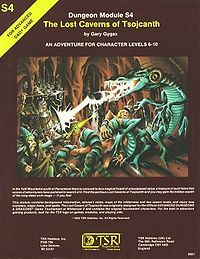 5. The Lost Caverns of Tsojcanth
5. The Lost Caverns of TsojcanthAs a kid, I adored this module, though much of my adoration came from the 32-page insert included with it. The insert featured a plethora of new monsters, many of them demons, which would later appear in the pages of the Monster Manual II, along with many new magic items. This sort of thing was like catnip to me at the time. But that insert is not the module itself. I've come to realize that, while the titular caverns are solid enough as an adventuring locale, they're not remarkable enough to warrant inclusion in my Top 10 list. With the benefit of hindsight, I realize now that my fondness for The Lost Caverns of Tsojcanth actually reflects my fondness for the year in which it was published – 1982 – and the possibilities I saw in AD&D's future rather than the content of the module proper. I still think there's a lot to like here, but not enough to have made my final cut.
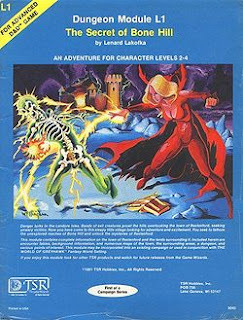 4. The Secret of Bone Hill
4. The Secret of Bone HillMy reasons for eliminating this module from the list was quite simple: it didn't see much use at my table back in the day. I've always regretted that. The Secret of Bone Hill is a very well presented low-level module. It has the potential, I think, to serve as a terrific kick-off to a new campaign. Indeed, I've heard of referees who've done just that and, by all accounts, this module is easily the equal of The Keep on the Borderlands and perhaps even The Village of Hommlet. But, as I said, my appreciation for it is largely academic, based almost entirely on reading its text rather than playing through it with others. As a kid, I swiped some elements of the module – like the skelters and zombires, which really impressed me at the time – for use in my own scenarios. I also repurposed some of its maps in a similar fashion. Beyond that, this was one of those modules I bought largely out of loyalty to TSR rather than because I expected to use it as intended.
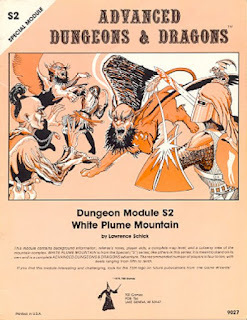 3. White Plume Mountain
3. White Plume MountainThis module is the quintessential "funhouse dungeon," which is why I so wanted to include it on my Top 10 list. Ultimately, it didn't make the final cut, because the list already included Castle Amber, a funhouse dungeon I played extensively and repeatedly back in my youth. Compared to that, White Plume Mountain is very much an also-ran. My friends and I had lots of fun with the module, but I only ever ran it once. In my Top 10 list, I placed a lot of importance of replayability and White Plume Mountain, for all its virtues, is more or less a one-and-done kind of dungeon. The characters go there for a specific reason – to recover the three stolen magic weapons – and, once they've achieved that goal, why go back? That's not a damning criticism, to be sure, but it's enough of one in my mind that I had no choice but to exclude it from my Top 10, despite my fondness for it.
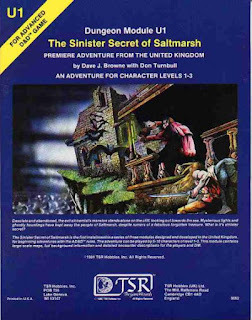 2. The Sinister Secret of Saltmarsh
2. The Sinister Secret of Saltmarsh Excluding this one hurts. In many respects, this module is perfect. It's got an excellent premise and is very well presented. That it's intended for use with beginning characters points even more strongly in its favor. On the other hand, its premise – that the supposedly haunted mansion of an alchemist is actually being used as a hideout for rather mundane bandits – works against it somewhat. I say that with some regret, as I quite like this "Scooby-Doo" approach, which I see as the culmination of Gygaxian naturalism in some respects. My experience, though, is that many players are disappointed when they discover that there's nothing actually supernatural going on and that everything happening has a purely rational explanation. Consequently, I have fewer fond memories of refereeing this than any of those included in my Top 10.
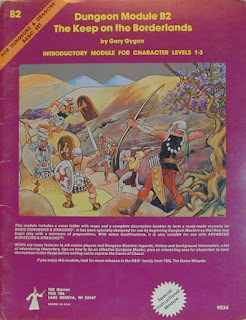 1. The Keep on the Borderlands
1. The Keep on the BorderlandsThis should not be a surprise. I have probably played module B2 more than any other D&D module, to the extent that I practically know many sections of it by heart. It's a fun scenario that's a great introduction to the game, so why not include it? Quite simply, I find it a little unimaginative these days. The titular keep feels very generic and underdeveloped (perhaps intentionally). The Caves of Chaos are a bit of a slog. Even the Shrine of Evil Chaos, which was my favorite part as a youth, feels lackluster, especially when compared to the lair of Lareth the Beautiful in The Village of Hommlet. These criticisms probably seem unfair and they might well be. I can only say that, speaking in 2021, I don't like The Keep on the Borderlands as much as I once did and that fact influenced my decision to keep it off the Top 10 list. Even so, I came very close to dropping The Hidden Shrine of the Tamoachan for it.
James Maliszewski's Blog
- James Maliszewski's profile
- 3 followers



